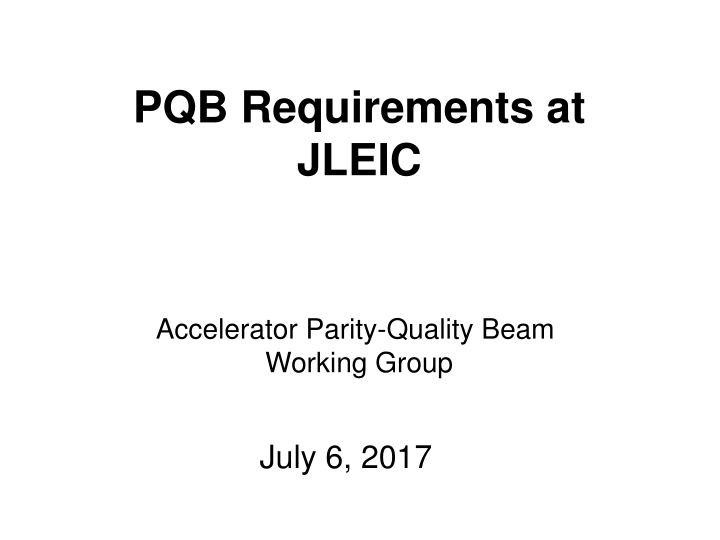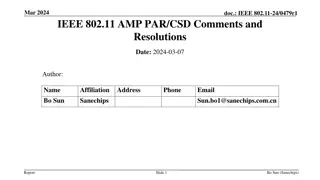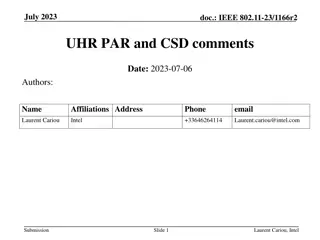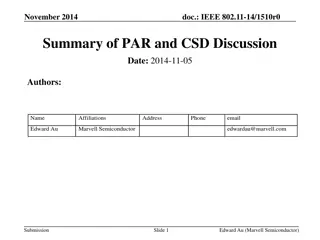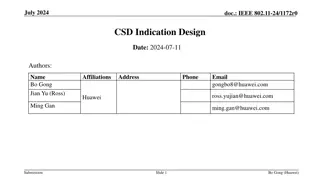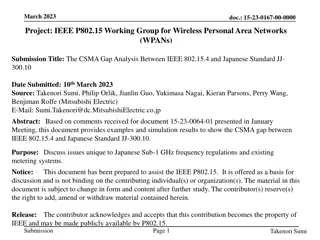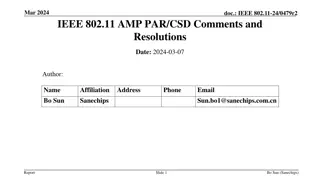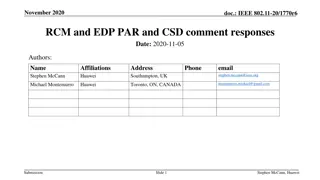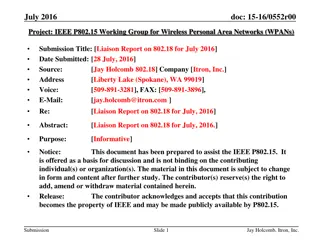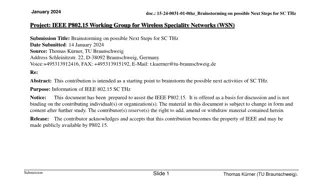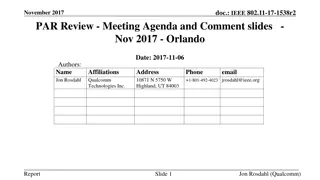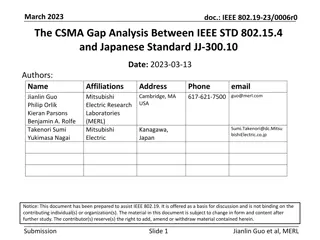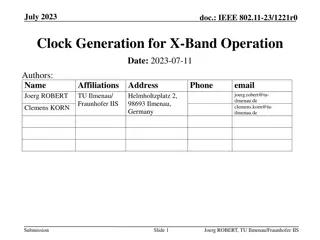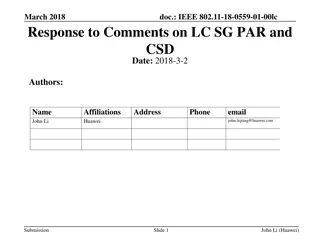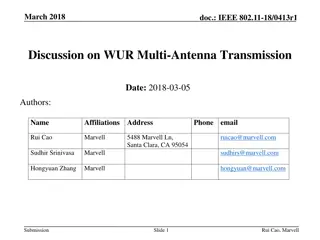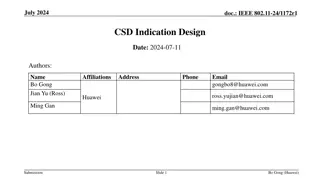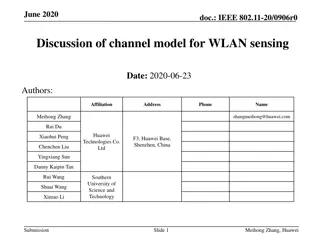IEEE 802.19-23/0025r2 Enhanced Sub-1 GHz Study Group PAR and CSD Comment Resolution
This document discusses the resolution of comments received on the PAR and CSD for the IEEE 802.19-23/0025r2 Enhanced Sub-1 GHz Study Group. It addresses recommended amendments and practices for improved coexistence in the sub-1 GHz frequency range, focusing on standards such as IEEE Std 802.11-2020 sub-1 GHz (S1G) PHY and IEEE Std 802.15.4 SUN. The proposals aim to enhance compatibility with legacy devices and address emerging market requirements, data traffic, and device density challenges.
Download Presentation

Please find below an Image/Link to download the presentation.
The content on the website is provided AS IS for your information and personal use only. It may not be sold, licensed, or shared on other websites without obtaining consent from the author.If you encounter any issues during the download, it is possible that the publisher has removed the file from their server.
You are allowed to download the files provided on this website for personal or commercial use, subject to the condition that they are used lawfully. All files are the property of their respective owners.
The content on the website is provided AS IS for your information and personal use only. It may not be sold, licensed, or shared on other websites without obtaining consent from the author.
E N D
Presentation Transcript
PQB Requirements at JLEIC Accelerator Parity-Quality Beam Working Group July 6, 2017
Parity Violation Particle Electric Charge Weak Charge Right/Left-handed Right-handed Left-handed -1 0 - e 0 ? Up quark + - 0 ? Down quark +1 0 1-4sin2 W (=0.08) proton 0 0 1 Neutron Electromagnetic (EM) interaction is same for Right-handed and Left- handed electrons (Parity is conserved) Weak interaction is different for Right-handed and Left-handed electrons: Left-handed electrons interact weakly but Right- handed do not (Parity is violated) 2
Parity Reversal Spin Electron Momentum Left-handed Electron ( Helicity) Right-handed Electron (+Helicity) Mirror Under Parity Reversal, Right-handed electron becomes Left- handed electron (Helicity Reversal) Changing electron s spin direction (Helicity Reversal) is equivalent to Parity Reversal 3
Experimental Techniques How to carry out a parity violation (PV) experiment: Scatter longitudinally polarized electrons off un-polarized target (i.e., hydrogen, deuterium, helium, lead) Reverse beam helicity ( ) with Pockels Cell, measure detected signals (N ) and currents (I ) per helicity, then calculate physics asymmetry (A physics): + N N Weak + I I = Aphysics 1/15th of a second + N N EM + + I I Repeat millions of measurements Statistical distribution of these measurements is Gaussian: Mean is average asymmetry and error is width of Gaussian divided by square root of number of asymmetry measurements Average asymmetry is very small (1 50 ppm) 4
Pockels Cell Pockels Cell is voltage controlled quarter wave plate Changes polarization of laser from linearly-polarized light to circularly polarized light E Field Linearly Polarized Light Circularly Polarized Light +HV: Right-handed circularly polarized light +Helicity electron -HV: Left-handed circularly polarized light -Helicity electron Pockels Cell HV 5
Helicity Correlated Beam Properties Charge Asymmetry: when average current of electron beam corresponding to one helicity state is different from other state, + I I = AI + + I I Effect of charge asymmetry is determined by experimental non-linearities (~few percent) We measure charge asymmetry of order 1 50 ppm Position Difference: when average position of electron beam corresponding to one helicity state is different from other state, + = x x x + = y y y Effect of position differences is determined by scattering cross section sensitivities We measure position differences of order 1 40 nm + = P P P Polarization difference between two helicities, : Effect of polarization differences is a systematic uncertainty of ?/? We measure polarization differences of order <1% 6
Rotatable GaAs Photocathode Attenuator IA Gain-switched Diode Laser and Fiber Amplifier LP HWP LP PC WP LP Shutter Helicity Control Board Helicity Flip Fiber 15 Dipole HV Supply (0 90 V) nHelicity Flip Fiber Vacuum Window Delayed Helicity Fiber T-Settle Fiber Hall RHWP Charge Feedback (IA) V-Wien Filter Target Spin Solenoids DAQ BCM Charge Feedback (PITA) H-Wien Filter BPMs Position Feedback Pockels Cell HV Supply (0 4000 V) IHWP CEBAF 5 MeV PZT Mirror Electron Beam Helicity Magnets 8
Experiment Energy (GeV) Pol (%) I Target Apv (ppb) Charge Asym (ppb) Position Diff (nm) Angle Diff (nrad) Size Diff ( / ) ( A) 38.8 100 1H HAPPEx-I 3.3 15,050 200 12 3 68.8 40 (15 cm) (Achieved) 1H 3,000- G0-Forward 300 300 7 4 3 1 3.0 73.7 40 (20 cm) 40,000 (Achieved) 3.0 87.1 55 1H 1,580 400 2 0.2 HAPPEx-II (Achieved) (20 cm) 23,800 3.484 89.4 100 1H 200 10 3 0.5 0.1 10-3 HAPPEx-III (Achieved) (25 cm) 208Pb PREx-I 657 60 85 1 1.056 89.2 70 4 1 10-4 (0.5 mm) (Achieved) 1.155 89.0 180 1H 281 46 8 15 5 1 0.1 0.02 10-4 QWeak-I (Achieved) (35 cm) 1.162 90 180 1H 234 5 <100 10 <2 1 <30 3 <10-4 QWeak (35 cm) 208Pb 500 15 <100 10 <1 1 <0.3 0.1 1.0 90 70 <10-4 PREx-II (0.5mm) 11.0 90 85 1H 35.6 0.74 <10 10 <0.5 0.5 <0.05 0.05 <10-4 MOLLER (150 cm)
JLEIC 11
JLEIC Polarized Source Bunch Charge 26 pC 6.6 pC 220 bunches at 68.05 MHz (14.69 ns) Helicity Reversal 72.07 s 700 ms 12 ms 3.233 s Damping Time 3 GeV 12 GeV Pockels cell switching time at CEBAF today ~70 s. Planned for Moller Exp. ~10 s Source rate of 68.05 MHz is 1/7th Collider collision rate of 476.3 MHz (PEP-II cavities) Harmonic number of ring is 3416 and revolution time is 7.17 s Half ring is filled with one helicity (1540 bunches 3.233 s) and second half is filled with opposite helicity (1540 bunches 3.233 s) Two gaps between two helicities (each 0.353 s) allow for beam abort, ion cleaning, turning on/off injection kicker, and detector readout Injection cycles repeat until ring is filled to required current 12
Time Structure of Polarized e- Injection Mid-cycle 1, inject the 1st of every 7 buckets in the ring Bunch train, down polarization Bunch train, up polarization 220 bunches, 3.233 s (Iave= 0.9mA @6GeV CEBAF) Waiting for damping 12- 700ms 14.69 ns, 68.05 MHz (7 ring buckets) 13 pC bunch 2ns, 476.3 MHz(ring freq.) Waiting for 72.07 s 3416*10.5turns/476.3MHz=75.3ms 12-700ms, ~2 e-ring damping time at different energy Note that: An average injected beam current of tens-of-nA level (same as or lower than initial injection beam current) can maintain a high equilibrium polarization in whole energy range Same time structure of polarized electron injection can be applied to both initial and top-off injections at a certain energy, but charge per bunch may/can vary Unit Energy GeV 3 6 10 Charge per bunch pC 26 13 8 Peak current (CW) mA 1.8 0.9 0.55 Pulse current A 0.015 0.035 0.175 Injection time min. 23 10 0.5 13
Polarized ions, non-polarized Electrons ~ A A e p Physics asymmetry is comparable: + + p e Access different combination of weak neutral-current coupling constants Can do both measurements at same time by averaging over either ion polarization or electron polarization Can fill ion ring with two helicities or one helicity may use weak solenoid to flip helicity. With one ion helicity, this solenoid maybe used to generate random flipping and delayed reporting. One helicity in ring will mitigate problems related to charge asymmetry. For one helicity, there is no need for a Pockels Cell, can use a quarter wave plate to generate one helicity. Ion Ring has 1 ms to 0.1 sec spin flipping with weak solenoid 14
Luminosity Differences Luminosity differences due to spot size, position or overlap differences Need luminosity monitor: located on both electron and hadron sides of interaction region cannot have too many luminosity monitors Luminosity lifetime is expected to be on order of a shift 15
Collider Ring Issues Helicity stable time is 3.233 s and detector readout time is 0.353 s for CEBAF, helicity stable time is 1 ms to 33 ms and detector readout time is 70 s Electron-ion bunches collides for many hours (on order of a shift) before bunches are aborted and fresh ones are injected in rings Continuous top-off injections will be used to apply charge feedback to zero charge asymmetry Gear switching, where number of ion bunches is different than electron punches, is necessary each electron bunch will interact with all ion bunches instead of one electron bunch interacts with same ion bunch all times No random helicity flipping or delayed helicity reporting from Pockels Cell How to deal with 60 Hz noise on beam? We asked CASA to consider spin flipping in electron ring similar to the ion ring 16
Example Assume Aphysics = 100 ppm Charge asymmetry of 1% and detector non-linearities of 2% (or deadtime differences) Error on asymmetry is 200 ppm must implement charge feedback If the ring is filled with one helicity flipping of helicity is done with a solenoid then the charge asymmetry can be very small P+ = 80% and P =70% Error on asymmetry is about 13 ppm, no need for polarization feedback. Again, with one helicity in ring, polarization differences (e.g., due to differences in depolarization) can be kept very small 17
Summary Measure charge and polarization per helicity window in Collider Ring do not assume polarization is equal for two helicities, may have different depolarization for two helicities Gear Switching is very important for parity violation experiments eliminate requirement on helicity correlated properties of ion beam Measurement of parity violation asymmetry in Collider Ring is limited by: I. Statistical Errors: ??~1/ ? where ? = 1034 cm-2 s-1 (compared to 1039 at CEBAF) Systematic Errors: due mainly to electronics cross talk since helicities must be known in real time no random helicity flipping or delayed helicity reporting II. Expect to measure parity violation asymmetries in Collider Ring to systematic errors of about ? ppm compared to CEBAF systematics of about 0.01 ppm, dominated by beam polarization uncertainty. Parity violating electron-nucleus scattering asymmetries have never been measured in a collider ring These techniques to reduce false asymmetries are also relevant to all experiments (e.g., double spin asymmetry) 18
APPENDIX I: Report of the Community Review of EIC Accelerator R&D
G. Injectors Discussion : Risk : Recommendations : 20
K. Polarization Manipulation Discussion : Risk : Recommendations : 21
APPENDIX II: Electronic Cross-talk & Ground Loop Elimination in CEBAF Injector
Electronic Cross-talk & Ground Loop Elimination in Injector VME Crate of Helicity Control Board is floating and powered with isolation transformer. o Helicity Board generates two real time helicity signals: Helicity Flip and nHelicity Flip. Current drawn by board does not depend on helicity state. o Helicity signal is generated by pseudo-random bit generator. No correlation between helicity signal and any other signal in Accelerator or in Hall. o Outside world receives only Delayed Helicity signal. This signal tells what helicity was in the past so there is no knowledge of real time helicity. o Helicity Magnets VME Crate which receives one of the two real time helicity signals (nHelicity Flip) is also floating and powered by isolation transformer. o Real time helicity signal (Helicity Flip) that goes to Laser Hut is isolated. All electronics that can see real time helicity are floating (next slide). o All helicity-correlated beam asymmetries (position, angle, charge, energy, and size and thus beam scraping) are minimized so helicity is the only real time property of beam that is changing. o Programming of voltage setpoints of Pockels Cell and IA s (both receive Helicity Flip signal) in Laser Hut passes through galvanic isolation card and there are no readbacks of these voltages. o
Normal Grounded VME CRATE FLOATING VME CRATE (slow status and control - nothing occurs at helicity flip rate) Helicity Control Board 16 bit DAC: Pockels Cell (PC) HV setpoints (0 4000 V) Helicity Flip Fiber 16 bit DAC: Hall A, B, C Intensity Attenuator (IA) HV setpoints RS-232: Rotating half-wave plate (RHWP) and laser attenuators IA0 Fiber IA1 Fiber Discrete Digital I/O: Insertable half-wave plate (IHWP) Injector Service Building Injector Tunnel Laser Hut Optical Switch Control Galvanic Analog/Digital Isolation Card PC +HV Supply Fast High Voltage Switch Floating Analog/Digital I/O PC -HV Supply IHWP RHWP & Attenuators IA HV Supply Pockels Cell To Floating Components AC Power Source Floating DC Power Halls IA s Floating Circuit Common
Fiber Cable Isolation Transformer Power Cable with Ground Pin Cut Ground Rod Floating VME Crate
T_Settle Helicity Flip 8 flips delay nHelicity Flip Delayed Helicity
